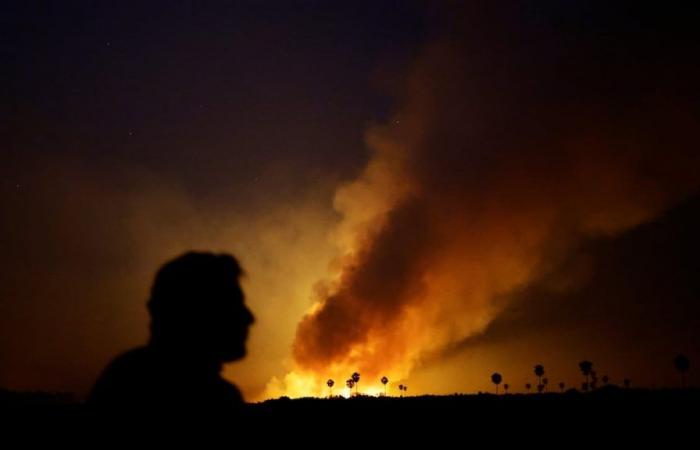Every year, the same paradox: flames become absolute protagonists in the largest flooded plain on the planet. When the dry season arrives, the Pantanal, which in addition to Brazil also includes part of Bolivia and Paraguay, becomes a tinderbox. They are the worst fires since 2020, when this valuable biome lost a quarter of its surface to flames. In the first 20 days of this month of June, more than 7,200 fire outbreaks were recorded, 3,000% more than in the same period last year, according to data from the National Space Research Institute of Brazil (INPE), which captures images via satellite. An area equivalent to 500,000 football fields has already turned into ashes this year in this paradise for jaguars. The Pantanal concentrates the world’s largest population of the feline.
In recent days the fire has been especially virulent around the city of Corumbá (Mato Grosso do Sul), where it has not rained for more than 50 days. With the fires and low humidity, the city, the epicenter of ecotourism in the region, has been taken over by dense smoke. Dozens of students from a school on the banks of the Paraguay River had to be evacuated by boat a few days ago due to the proximity of the flames. The drought and the low flow of this river are among the main factors that explain this explosion of fires.
The Paraguay is the main river of the Pantanal, but in its Brazilian stretch it is three meters below its usual level for June. In May, the National Water Agency declared a “critical” situation in this hydrographic basin for the first time in history. With the lack of rain in recent months, the bushes and grasses are transformed into straw, the perfect fuel. The Pantanal, like the Amazon, usually suffers from the dry season in the second half of the year, but climate change, now aggravated by the effects of El Niño, is increasingly advancing the risk calendar.
The president of Ibama (the Government’s environmental protection agency), Rodrigo Agostinho, remarked last week that the situation is absolutely unprecedented: “We never had a fire in the first half of the year in the Pantanal. In the first half of the year the Pantanal was always under water,” he recalled. At the beginning of this month, when the fire was already appearing strongly, President Luiz Inácio Lula da Silva signed a pact for the prevention and control of fires with the governors of the States that make up the Pantanal and the Amazon.
The plan is basically focused on exchanging information and integrating databases, but it does not have a specific budget allocation. During the signing of the pact, the Minister of Environment and Climate Change, Marina Silva, suggested that the Government mobilize “extraordinary resources, extraordinary means and also extraordinary legal actions for the hiring of brigade members”, without detailing figures.
The most that has been achieved is the temporary hiring of brigade members who in the coming months will be divided between the Pantanal and the Amazon. There will be barely 2,000 people fighting the fire on an area larger than the European Union. The Lula Government’s environmental policy, despite positive data such as the drop in deforestation in the Amazon, suffers from economic constraints. Thousands of environmental officials have stopped working in the field to demand job improvements. Their absence in the countryside has been noted in the months prior to the crises, when fines are issued and who deforests and then burns the remains is monitored.
In the Pantanal, the persistence of fires puts in check the ability of this valuable biome to regenerate naturally, as, in many cases, the flames devour vegetation that was still recovering from previous fires. In this way, there are fewer and fewer corners of the Pantanal with adult trees and the complete and original ecosystem. A recent MapBiomas study indicates that almost 60% of the Pantanal has burned at some point in the last 40 years, nine million hectares.
Wetlands are home to 40% of the world’s animal and plant species and are key to mitigating the effects of climate change because they store a quarter of all soil carbon. A study released this week by the Environmental Justice Foundation (EFJ) regrets that, despite their importance, the political measures to protect them are not up to par. 35% of the world’s natural wetlands disappeared in just 45 years, from 1970 to 2015, a rate of destruction three times more intense than that of forests and much less publicized.
Most fires in the Pantanal are caused by humans, either intentionally or accidentally. Many due to carelessness when burning stubble. Others, deliberately to make space for pastures for livestock. For this reason, environmental organizations such as EFJ demand that the EU include wetlands in the regulations that prevent the import of products from illegal deforestation. At the moment, only the forests are contemplated.
Follow all the information from El PAÍS América in Facebook and xor in our weekly newsletter.






